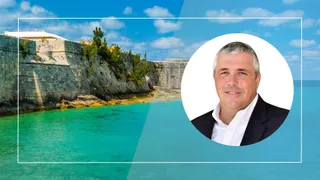
Reinsurers brace for midyear renewals as question mark hovers over capital
Signs that the hard market is softening will lead to reinsurers being more protective of capital, says AM Best’s Dan Hofmeister (pictured).
The reinsurance industry, often seen as the backbone of risk management, is currently navigating particularly complex terrain.
That is the view of Daniel Hofmeister, associate director at AM Best, who was interviewed by Bermuda:Re+ILS at the Bermuda Risk Summit last month.
“The market keeps softening,” Hofmeister observed, “and maybe the reinsurers have taken a back seat a little, allowing it to happen. Or it will return to reinsurers being in control.
“That would seem more likely.”
This tug-of-war between reinsurers and market forces has been amplified by recent losses, and Hofmeister noted that investors in insurance-linked securities were also feeling cautious, particularly after significant first-quarter losses from the California wildfires.
“It’s tough for them to get investors comfortable if you’ve just had a huge first-quarter loss, and now you’ve got to get through the rest of hurricane season, while fundraising for the next year,” he said.
With heightened awareness of capital constraints, reinsurers are adopting a more protective stance, he said.
“As we go into this renewal, reinsurers are going to be a bit more protective of the way they deploy their capacity.
“And they have reason to, as these losses shouldn’t be priced in the mid-year renewals, but ultimately, they’re going to be more cautious for capital.”
Wildfires, wealth, and widening gaps
Hofmeister addressed the increasing challenges posed by secondary perils, particularly wildfires.
“Reinsurers aren’t going out there trying to write wildfire cat; it’s mostly hurricane pricing. Wildfires are a unique situation,” he said.
On the issue of protection gaps, Hofmeister pointed out a unique dichotomy in the California wildfires: “It’s odd because a lot of it involves extremely wealthy individuals with less coverage than they probably should have.
“It doesn’t pull at the heartstrings as much as the losses in impoverished areas.”
Attachment points for reinsurance are another issue, with Hofmeister noting that “some of these are approaching the top end of the tower”.
He had one cautionary note to offer: “ If you’ve nearly exhausted your CAT coverage and are still profitable in a given year, you should probably re-examine your limits.”
This points to a broader issue in the industry: balancing risk appetite with appropriate levels of protection, especially as new risk dynamics emerge.
Shifting focus to Bermuda, Hofmeister was optimistic about its reinsurance market.
“The state of Bermuda is very positive, and there are a lot of really strong companies that have put themselves in a good position,” he said.
Hofmeister then highlighted the strong performance of key players. “Look at what Arch or RenRe have done: they’ve really put up spectacular results,” he said, adding: “RenRe was the property cat specialist for such a long time, but has continued to diversify.
“Everest is a large, diversified player, and PartnerRe has been a long-term participant in the market throughout cycles,” he continued.
Bermuda’s resilience, Hofmeister said, is partly due to its regulatory framework.
A collaborative approach has helped mitigate concerns around corporate income tax changes and maintained Bermuda’s attractiveness as a reinsurance hub, he said.
“Bermuda’s done a great job of working together with their clients from a regulatory standpoint,” he confirmed.
“We’re coming up to a crossroads. We’ll soon see where the market’s headed.”
Innovate or stagnate
Looking ahead, Hofmeister emphasised the need for innovative solutions to address emerging risks.
“There’s certainly demand for something different,” he said.
Secondary perils, such as wildfires and Midwest storms, are particularly challenging for insurers.
“There’s a need for an aggregate-type cover for the industry,” Hofmeister suggested, admitting that the challenge lay in finding profitable ways to offer such coverage.
He noted that parametric models showed promise but remained in their infancy.
“Parametrics are difficult for a management team to grasp, and for them to put enough money behind it to make a difference.”
He also mentioned the innovative edge of the industry.
“We’ve heard about MGAs coming in with business models to focus on some of those parametric models. It seems promising, but the models are still at the infancy stage.”
Despite these challenges, Hofmeister expressed a cautiously optimistic outlook for the industry.
“Reinsurers are in a strong position,” he said. “Pricing and underwriting terms and conditions are still pretty favourable.”
However, he acknowledged the uncertainty surrounding mid-year renewals.
“We’re coming up to a crossroads,” he explained. “We’ll soon see where the market’s headed.”
Hofmeister concluded by highlighting the importance of stability and consistency. “The market’s in a good spot now,” he said.
“Not without concerns, but reinsurers have pricing and underwriting conditions in their favour.”
Five key takeaways
Proactive capacity management: Reinsurers must remain vigilant in deploying capacity, particularly in light of recent losses and the upcoming hurricane season.
Adapting to new risks: Secondary perils, such as wildfires, require innovative solutions and a rethinking of traditional pricing models.
Leveraging regulatory strengths: Bermuda’s example highlights the value of a strong regulatory framework in maintaining market stability.
Innovating for the future: Developing aggregate covers and exploring parametric models could address unmet demand, but profitability remains a key challenge.
Staying resilient amid uncertainty: With favourable pricing conditions, reinsurers are well-positioned to navigate upcoming renewals and maintain their influence in the market.
Did you get value from this story? Sign up to our free daily newsletters and get stories like this sent straight to your inbox.

